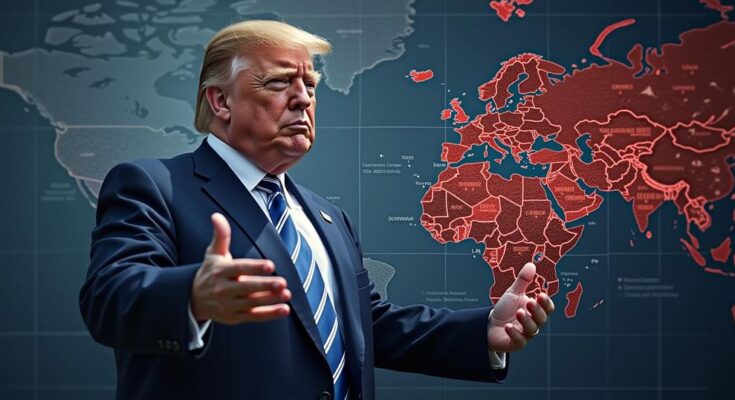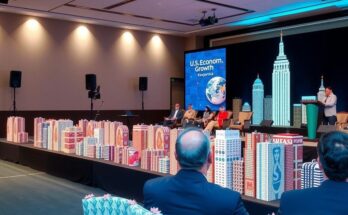Donald Trump’s economic proposal involves aggressive tariffs aimed at bringing back U.S. manufacturing and reducing costs, particularly targeting China. However, economists warn this could lead to increased consumer prices and disrupt global trade, ultimately resulting in inflation without guaranteed benefits for American production.
Former President Donald Trump, in his quest to restore American manufacturing and reduce consumer costs, is leaning heavily on an aggressive tariff strategy. His approach seeks to net billions for the U.S. Treasury and press foreign nations—particularly China—to mend their trade practices, which he claims have been exploitative. Yet, this bold vision masks a complex reality, as economists raise alarms over the potential backlash from these policies. Trump’s proposals include a sweeping 10 to 20 percent tariff on imports and an astonishing 60 percent on Chinese goods, following recent threats of a staggering 200 percent tariff on Mexican automobiles. He insists that these tariffs would enable the U.S. to reclaim manufacturing supremacy lost over decades. At a Michigan rally, he declared, “Tariffs, to me, are the most beautiful word.” However, the implications of such tariffs extend beyond the boardroom. While discussing the economic landscape, experts warn that these policies could inadvertently elevate inflation and disrupt global trade with uncertain outcomes that may hinder rather than help American production. For instance, the Peterson Institute for International Economics (PIIE) projects that a universal tariff could raise U.S. inflation by 1.3 percentage points above current levels. Bernard Yaros from Oxford Economics estimates a similar rise, with inflation peaking at 0.6 percentage points under a Trump administration. Moreover, the fundamental burden of tariffs typically falls on U.S. businesses, which must cope with increased costs of imported goods—burdens that are often transferred to consumers in the form of higher prices at the store. Kyle Handley, a UC San Diego professor, echoed this, stating that if tariffs are implemented, consumers will undoubtedly witness price hikes. He lamented, “There’s no way we’re not going to see that on store shelves.” Moreover, Trump’s rhetoric regarding revitalizing U.S. manufacturing overlooks the reality that American factories lack the capacity to meet domestic demands, given that numerous goods, such as televisions, haven’t been produced in the U.S. for decades. Complicating this situation, economist analyses indicate that previously imposed tariffs have already incurred a substantial monthly cost of around $3.2 billion to U.S. consumers and importers by late 2018. In terms of trade dynamics, Trump’s tariff plans could decimate U.S.-China trade by up to 70 percent, resulting in a redirection of hundreds of billions in exchanges and a potential 10 percent decrease in U.S. trade volumes overall. While these tariffs might promise an additional $500 billion in annual revenue, analysts suggest that the anticipated figures could dwindle to around $200 billion due to rerouted trade. Trump’s vision extends to energy policy, where he guarantees the elimination of inflation, aiming to reduce energy bills significantly through deregulation. Yet, expectations are mixed concerning the actual benefits of deregulation, as they rely heavily on the actions of major producers who prioritize shareholder interests. Moreover, while Trump seeks to lower food prices by restricting foreign agricultural imports, experts warn that such barriers could quickly provoke retaliatory measures, jeopardizing U.S. farmers who rely significantly on exports.
In the brewing storm of the political arena, Trump’s economic agenda comes as a multifaceted strategy aiming to propel American manufacturing back into the spotlight. His proposed tariffs are framed as a tool to rectify, what he portrays as, long-standing trade injustices perpetrated by nations like China. However, the daunting interplay between tariffs, potential inflation, and trade dynamics could yield unpredictable results in the economic landscape as the presidential election looms, creating a cloud of uncertainty for American consumers and industries alike. The balance of taxing imports while simultaneously advocating for tax cuts paints a contradictory picture that invites scrutiny from economic experts and analysts alike and deepens the complexities inherent in Trump’s ambitious vision for America’s economic resurgence.
In conclusion, Trump’s ambitious economic plan, anchored on sweeping tariff strategies and tax cuts, presents both an alluring promise of revitalized manufacturing and a disquieting potential for inflation and trade disruption. As policymakers, economists, and consumers navigate this intricate web of economic shifts, the need for a balanced approach that considers both short-term gains and long-term stability becomes increasingly evident. While Trump may champion his tariff proposals as a panacea, the broader implications for American consumers and the global trade landscape suggest a far more complex reality, urging a reevaluation of the true costs of his economic vision.
Original Source: www.northwestsignal.net



